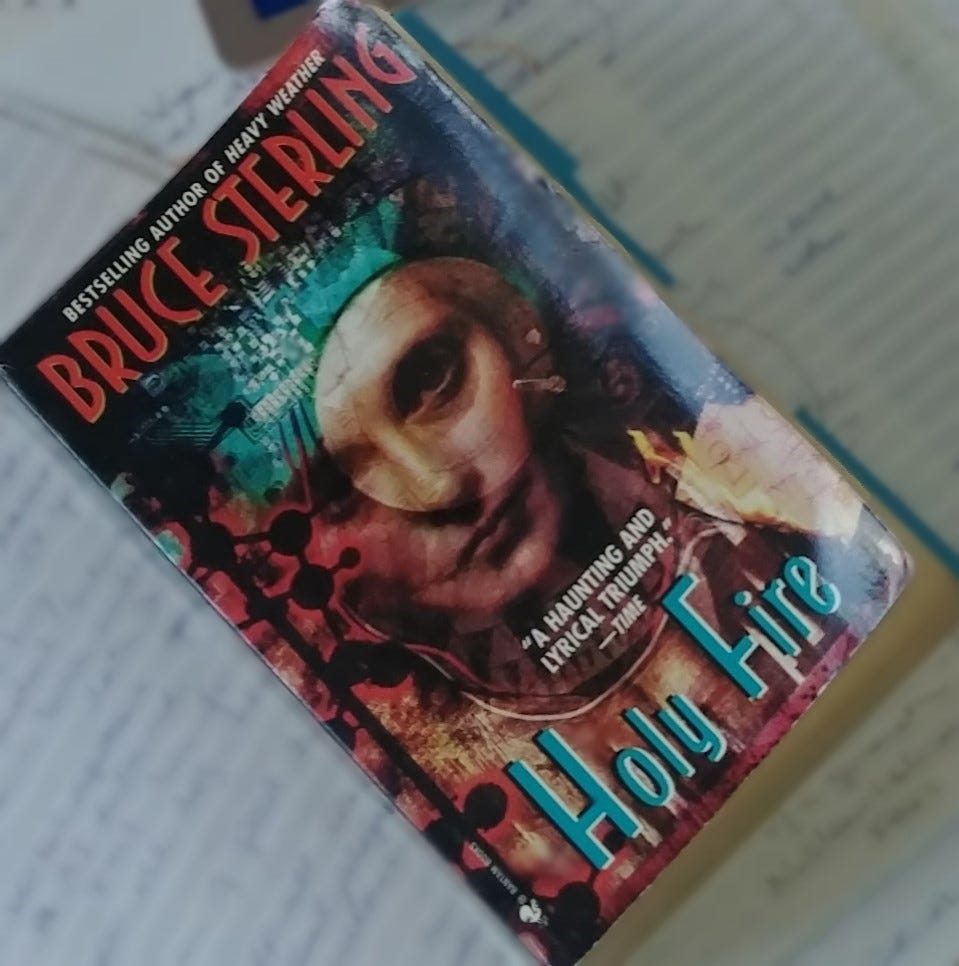Reposting a favorite book review while on hiatus until September.
Have a great summer, see you in the fall!
Holy Fire by Bruce Sterling
In the science fiction novel, Holy Fire, first published in 1996, Bruce Sterling tells a compelling story about a woman’s quest for meaning in a not-too-distant future. The story takes place in 2096, with references to plagues, political and technological uprisings through the century. Yet, a main theme of the novel is the characters’ nostalgia for their past history. Sterling’s writing is lyrical and sophisticated. His writing appeals to the educated mind, both in style and in theme.
Mia Ziemann is a gerontocrat, aged 90, wealthy. The first chapter opens with her unsettling visit to a former lover on his deathbed; he remembers their youthful affair as a significant turning point in their shared history. Disturbed by this encounter, she impulsively undergoes a medical fountain of youth procedure which transforms her body as if it were a youthful twenty years old. The life extending reconstruction procedure also results in an unanticipated side effect, an altered mind state; she is partially amnesiac. The ingrained attitudes and experiences of the elder Mia’s mind battle with her new identity as a medically rejuvenated youth. Feeling like a new person, Mia renames herself as Maya.
Disoriented by the side-effects, Maya takes off for Europe as a rebellious runaway, fueled by a yearning that she cannot articulate. Her Mia-minded memory is dormant. At first, she makes her way by intuition and coincidence, celebrating the freedom and courage of youth. The quest plot, a road trip through Europe, provides the setting for Maya/Mia to meet up with various artists, activists, and students on the fringe. They engage in philosophical and political dialogues about being vivid, being fully alive, not accepting the status quo.
Gradually, the amnesia wears off, and Maya/Mia takes advantage of her wisdom gained throughout the previous century, to follow through on her second chance at life. The characters that accompany her on this daring adventure give voice the eternal search for holy fire, the attempt to define what it means to live fully; they strive to be conscious of what thoughts and behaviors are meaningful, important, effective in leading the life they want.
In 1996, when I first read this novel, I was at university, about to embark on a career as a teacher. I had recently come back from living in Japan, teaching English conversation. Maya/Mia’s dialogues with the other characters had a great appeal for me as a student searching for answers on how to shape my future, and the paperback has remained on my bookshelves since.
I read Holy Fire periodically to revisit the questions about taking a stand on a belief, or impulsively following a wish for something better. As reader, placing myself in Maya’s role, I remember my own world travels and how I relate to the people I’ve met. I wonder at the powers of the mind, how memories of experiences construct an identity. What conscious and unconscious aspects feed into my decision-making.
With the most recent reading of Holy Fire, I am transitioning away from the career that started with my teaching degree in the mid-1990s, and I, like the characters in the novel, am reminiscent about my past. This novel has accompanied me through thirty years of internal debates, similar to the Maya/Mia aspects of my own mind. The adage about ‘wishing I knew then, what I know now’, arises as a theme.
If I were given a second chance with my mind and body, knowing what I know now, would I do things differently? What choices influence my life’s trajectory - am I becoming more like Mia, the conservative elder, or Maya, the adventure seeking youth?
The debate about one’s choice to live life to the fullest as a free thinker who cares for enlivening the soul, or to live conservatively as gerontocrat who preserves money and tradition, are timeless questions, well worth considering as the reader engages with this novel. Balancing the extremes, as articulated in the novel, requires personal journeys, supportive friends, and sources of timeless wisdom.
To live fully, to be vivid, as Sterling’s characters explain, one makes conscious choices about how to think and behave. Vivid people make themselves aware of the external conditions that establish the status quo, and decide if they agree or not with the rules set out by others. The characters prompt each other, and the reader, to wonder what it takes to express joie de vivre?
Bruce Sterling’s novel, Holy Fire, captures the reader with a rollicking road trip adventure story, with each character adding their philosophic wisdom on the search for meaning. It’s a story worth reading multiple times. This book has accompanied me for so many years; Maya’s companions feel like my old friends.


